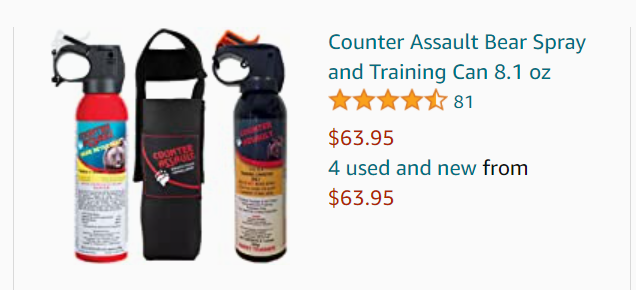The answer: When you think you may encounter an aggressive or charging bear; a user points the canister at an aggressive bear and sprays the contents for 2–3 seconds. The maximum range of sprays by different manufacturers varies, but they are reported to be effective when sprayed at a charging or aggressive bear from a distance of 1.5 to 3 meters (4 ft 11 in to 9 ft 10 in). Bear spray uses a fine cloud of derivatives to reduce a bear’s ability to breath, see, and smell, giving you time to leave the area.
The key active ingredients of bear spray are 1–2% capsaicin, and related capsaicinoids--the same ingredients found in pepper spray.
Pepper spray was created in the late 1970s and used for riot control by law enforcement agencies beginning the early 1980s. Oleoresin capsicum (OC) is the active agent in pepper spray, which is an oily concentrated extract from plants of the genus Capsicum, more commonly referred to as the chili pepper.
OC resin is solid at room temperature, so it is dissolved in organic solvents allowing use as an aerosol.
All formulations of tear gas stimulate transient receptor potential (TRP) channels.
TRP channels are ‘cellular sensors’ that are heavily expressed in nociceptors (sensory neurons that are noxious stimulus detectors) that respond to changes in the cellular environment, including temperature, stretch/pressure, chemicals, oxidation/reduction, osmolarity, and pH, both acidic and alkaline. These channels are found in peripheral sensory nerves and are present in all organs, including skin, conjunctiva, cornea, and mucous membranes of the upper and lower airways.
Capsaicin stimulates TRP channels in nociceptors.
For example, when TRP receptors in the airway are stimulated by OC, the sensation of pain occurs. There is also an inflammatory response, due to the process of neurogenic inflammation. Neuropeptides (including importantly substance P) are released at the terminals of the C (and special A) fibres, both peripherally and at their junction in the dorsal horn of the spinal cord. These neuropeptides in turn provoke inflammation.
I’m sure you are aware of the clinical picture following exposure to these agents. Ocular and respiratory symptoms, burning pain in the skin and airways, inflammation of the eyes, cough, SOB, chest pain, HA, dizziness and even syncope.
Treatment is removal from the area and supportive care. Copious irrigation of the eyes is needed-and potentially of the skin as well, depending on the exposure. Repeated or prolonged exposure can cause more serious injuries.
As for the Bear Spray: (you can get it on Amazon)
Do not use bear spray like insect repellent. It does not work as a deterrent when applied to people or equipment
If you really want to learn how to use bear spray:
Https://www.nps.gov/yell/learn/nature/bearspray.htm3

This question was prepared by Donna Seger, MD
I am interested in any questions you would like answered in the Question of the Week. Please email me with any suggestion at donna.seger@vumc.org.
Donna Seger, MD
Executive Director
Tennessee Poison Center www.tnpoisoncenter.org
Poison Help Hotline: 1-800-222-1222